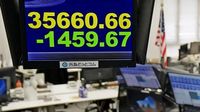Asian shares tumbled on Monday, March 31, 2025, as investors reacted to growing concerns about the U.S. economy amid escalating trade tensions and inflationary pressures. The financial markets in Tokyo and Taiwan saw declines of more than 4%, while the price of gold surged to a record high of nearly $3,150 an ounce, reflecting a shift toward traditional safe havens.
In Tokyo, the benchmark index fell 4.1% to close at 35,617.56, while Taiwan's Taiex plummeted 4.2%. The Hang Seng index in Hong Kong lost 1.2%, closing at 23,135.01. The Shanghai Composite index declined by 0.5% to 3,335.67, and South Korea's Kospi dropped 3% to 2,481.12. Australia's S&P/ASX 200 sank 1.7%, finishing at 7,843.40. The overall sentiment was echoed in the U.S. markets, where the S&P 500 experienced a 2% drop on Friday, March 28, marking one of its worst days in two years.
Concerns about the U.S. economy are mounting as households exhibit fear of spending, largely due to the deepening trade war under President Donald Trump. On Friday, the Dow Jones Industrial Average fell by 715 points, or 1.7%, to 41,583.90, while the Nasdaq composite dropped 2.7% to 17,322.99. Lululemon Athletica led the market decline with a staggering 14.2% drop, despite reporting stronger-than-expected profits. Oxford Industries also saw its stock fall by 5.7% after a positive earnings report.
Stephen Innes of SPI Asset Management pointed out that Asia is at the heart of the trade war, noting that nine of the 21 countries currently under scrutiny by the U.S. Trade Representative are in Asia. "Asia is ground zero," he stated, emphasizing the vulnerability of nations reliant on export manufacturing.
Adding to the turmoil, Thailand's SET index lost 1.5% following a powerful earthquake centered in Myanmar that caused widespread destruction and left dozens of construction workers missing in a collapsed building. Shares of Italian Thai Development, the developer of the high-rise office building, plummeted 27% in response to the disaster.
Simultaneously, the economic landscape is increasingly strained for manufacturers in China, particularly as U.S. tariffs continue to rise. Richard Chen, who produces Christmas decorations for U.S. retailers, reported a dramatic drop in orders, stating, "The orders are half of what they were last year. There’s no more scope to cut prices." President Trump implemented a new 10% tariff on February 4, 2025, which has compounded the challenges faced by low-margin manufacturers.
Manufacturers are caught between rising costs and pressure from U.S. buyers demanding price cuts. U.S. clients are asking for an average discount of 10%, but ongoing negotiations have only yielded reductions of 3% to 7%. Liz Picarazzi, CEO of Citibin, shared that her goods are now subject to tariffs totaling 52.5%, making manufacturing in China unfeasible. "My whole business has been based on a long-term rate of 7.5%. It's been a real shock," she explained.
Economic pressures have led to fears of substantial layoffs in China as factories struggle to cope with the financial burden of tariffs. He-Ling Shi, an economics professor at Monash University, noted that many enterprises are closing their doors, with academic research indicating that each 1% increase in tariffs reduces supplier margins by 0.35%. The previous trade war in 2018 resulted in the loss of approximately 3.5 million manufacturing jobs in China, and analysts are concerned about the potential impact of the current tariffs.
As the situation evolves, some U.S. customers believe that Chinese authorities may intervene to support local manufacturing industries with tax rebates and subsidies. However, many suppliers have reported that such support has yet to materialize, as local governments face significant financial strain due to an ongoing property crisis.
Despite the challenges, the message from Beijing encourages exporters to pivot to other markets and tap into China’s vast domestic consumer base. Yet, this strategy poses its own difficulties amid overcapacity and declining domestic demand.
In the midst of these economic challenges, the global financial landscape remains uncertain. As the U.S. approaches a Wednesday deadline for additional tariffs, the markets are on edge. The upcoming tariffs, which Trump has dubbed "Liberation Day," are expected to be tailored to each of the United States' trading partners, further complicating the economic outlook.
On the commodities front, U.S. benchmark crude oil prices fell slightly, losing 4 cents to $69.32 per barrel, while Brent crude oil dropped 2 cents to $72.74 per barrel. The U.S. dollar also weakened against the Japanese yen, falling to 149.02 from 149.84, while the euro rose to $1.0839 from $1.0803.
As the global economy grapples with these challenges, policymakers in Washington face a daunting task. The potential for stagflation looms as inflation remains high while economic growth falters. With few tools at their disposal, the outlook for both the U.S. and Asian economies remains precarious.





